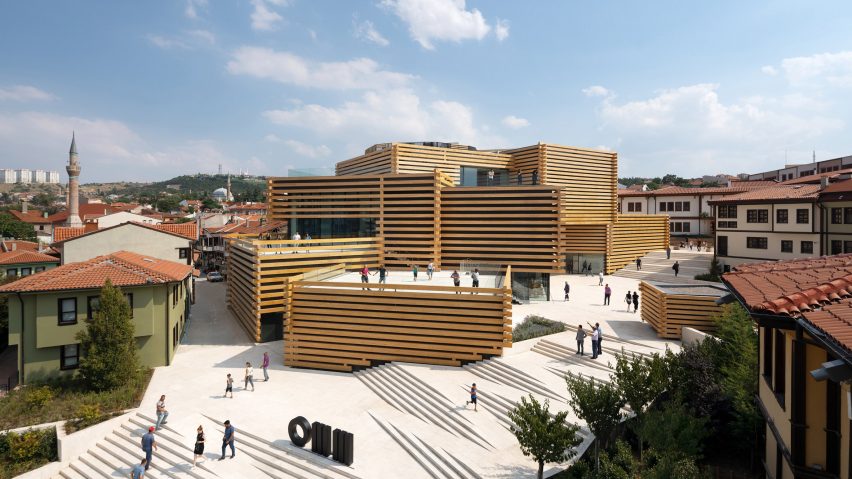The Odunpazari Modern Museum, designed by Kengo Kuma and Associates, has opened its doors in Eskisehir, northwest Turkey.
Built to house the modern art collection of architect and chairperson of Turkish contractor Polimeks, Erol Tabanca, the museum in the Odunpazari district of Eskisehir is formed of a cluster of boxes made from stacked, interlocking timber beams.
Odunpazari, which means firewood market in Turkish, used to be a centre for timber trading and Kengo Kuma and Associates took this history as the basis for the design.
"Timber is really important to the town's heritage," said Yuki Ikeguchi, the partner leading the project at Kengo Kuma and Associates.
"Ensuring that the building spoke to the history and memory of its setting was always front and centre in our minds. It has been always our practice's keen interest to build with timber that gives comfort and warmth to the space and is kind to the environment."
The building consists of a group of square-shaped blocks that are surrounded by laminated-timber beams stacked on top of each other. These have been arranged to continue the streetscape of the surrounding Ottoman houses.
"Cantilevers and rotation makes the streetscape and walkthrough experience very special and unexpected," explained Ikeguchi.
"It was my intention to make a link to the unique character of the Ottoman houses adjacent to the site by stacking and rotating the boxes that offer the opportunity to house exhibitions and activities in various scales," she continued.
"Not just in the formalist manner, but to continue the streetscape and recreate the non-linear journey of visiting the inside of the museum."
The museum will display items from Tabanca's 1,000-piece collection of modern and contemporary art, alongside temporary exhibitions.
The building is designed so that there are smaller, more intimate spaces on the lower floors, with larger, open galleries for events and exhibitions on the upper floors. It also contains a cafe and a shop.
At the centre of the building, where four of the stacked blocks meet, there is a skylit atrium that stretches the full height of the three-storey building.
This timber-lined square skylight twists gently as it rises through the building.
The museum opens out onto a large plaza with steps that run up alongside the building, which connects an area of older housing with a new development.
"The idea for OMM was to use architecture to create a link between people and art," said Ikeguchi.
"We were deeply inspired by the history, culture, people and streetscape of Odunpazari, and we wanted the building to resonate on many levels. We hope that the museum will breathe new life into Eskisehir and become a central and inviting meeting point for the city," she continued
"I hope visitors will feel excited and comfortable and that the museum will be a more than just a place to enjoy the art. I hope they will sense the connection to the history and the memory of the place that links to the future."
Kuma founded Kengo Kuma and Associates, which has offices in Tokyo and Paris, in 1990. The studio has completed numerous cultural projects around the world, the most recent being the V&A in Dundee.
Kuma is currently designing the Hans Christian Andersen Museum in Denmark and a cultural centre in a former slaughterhouse in Porto.
Photography is by NAARO.

